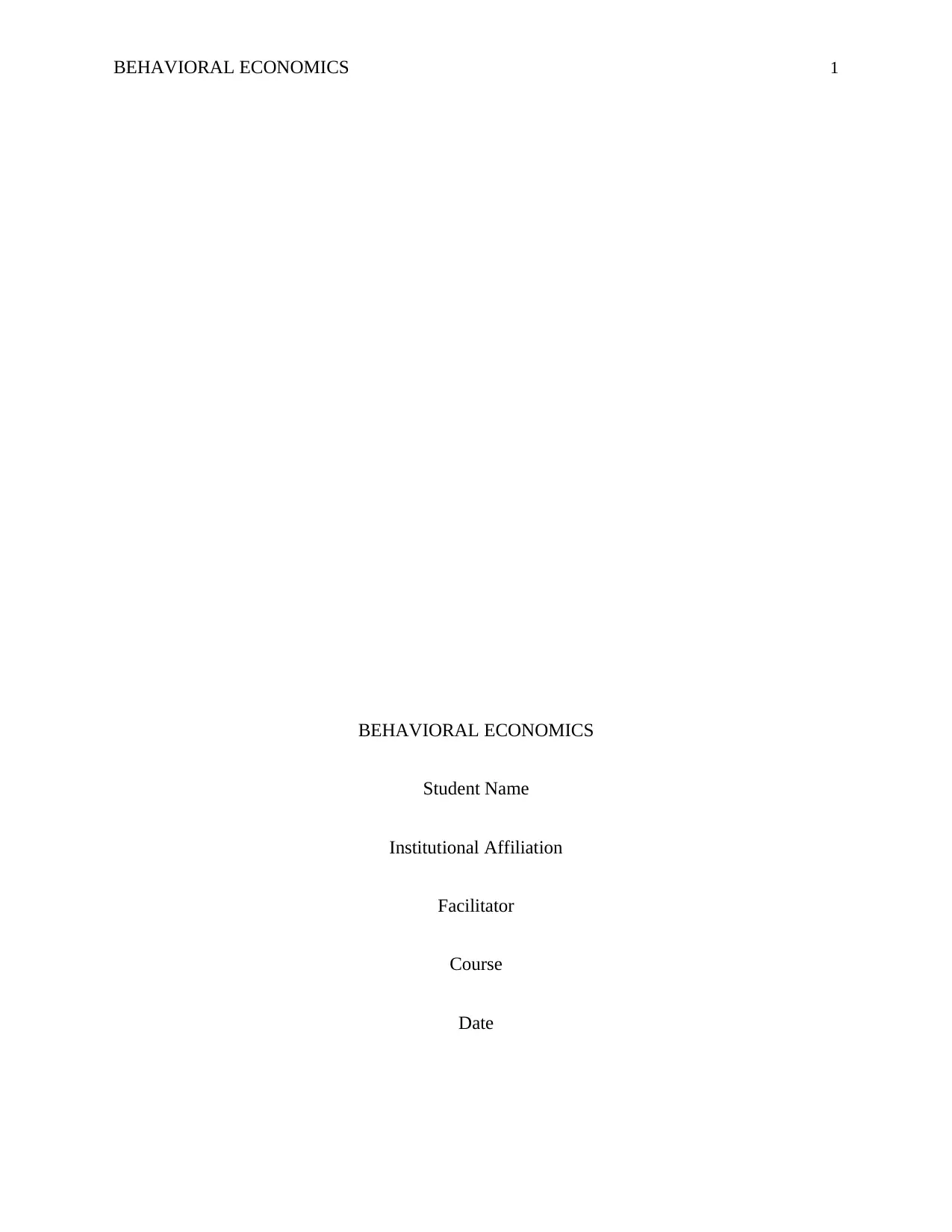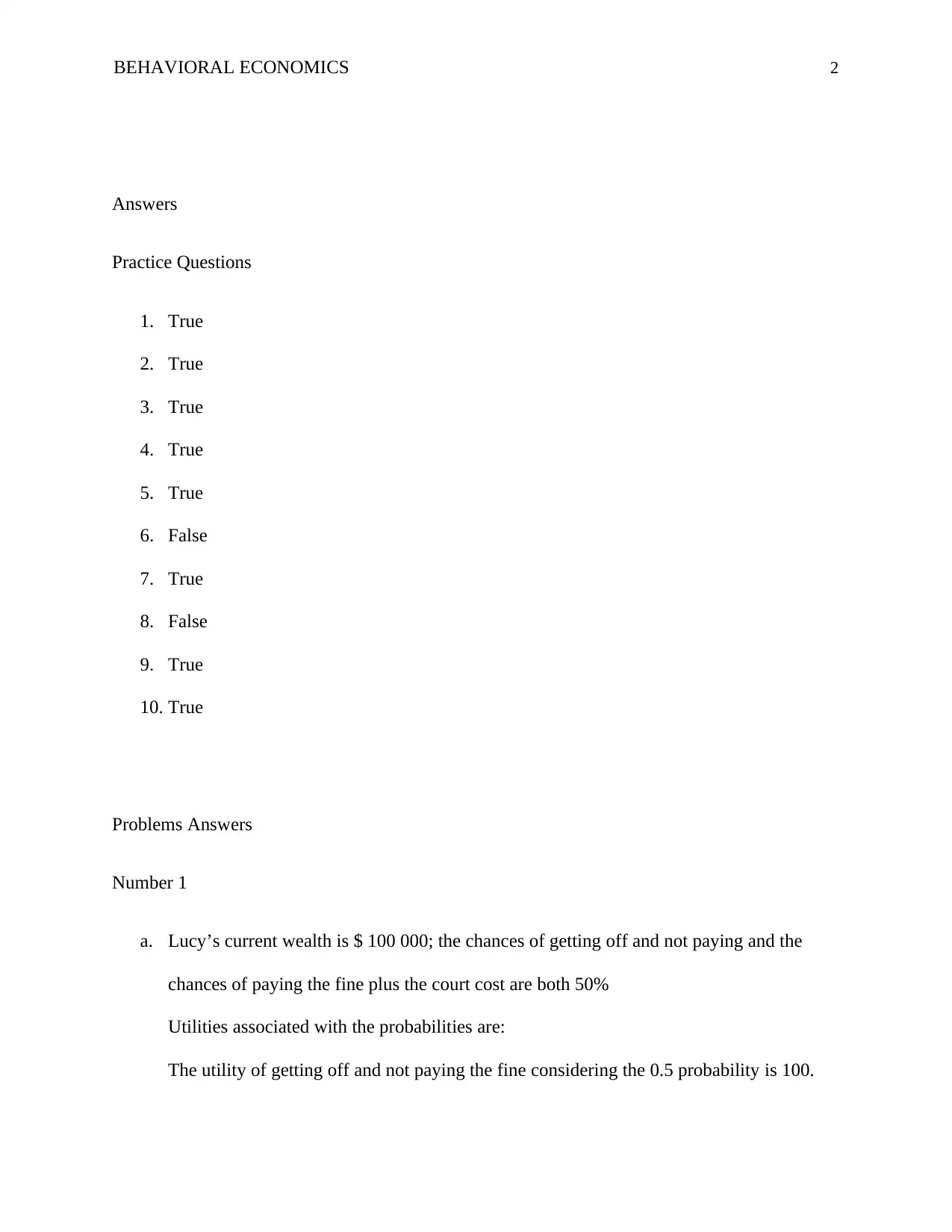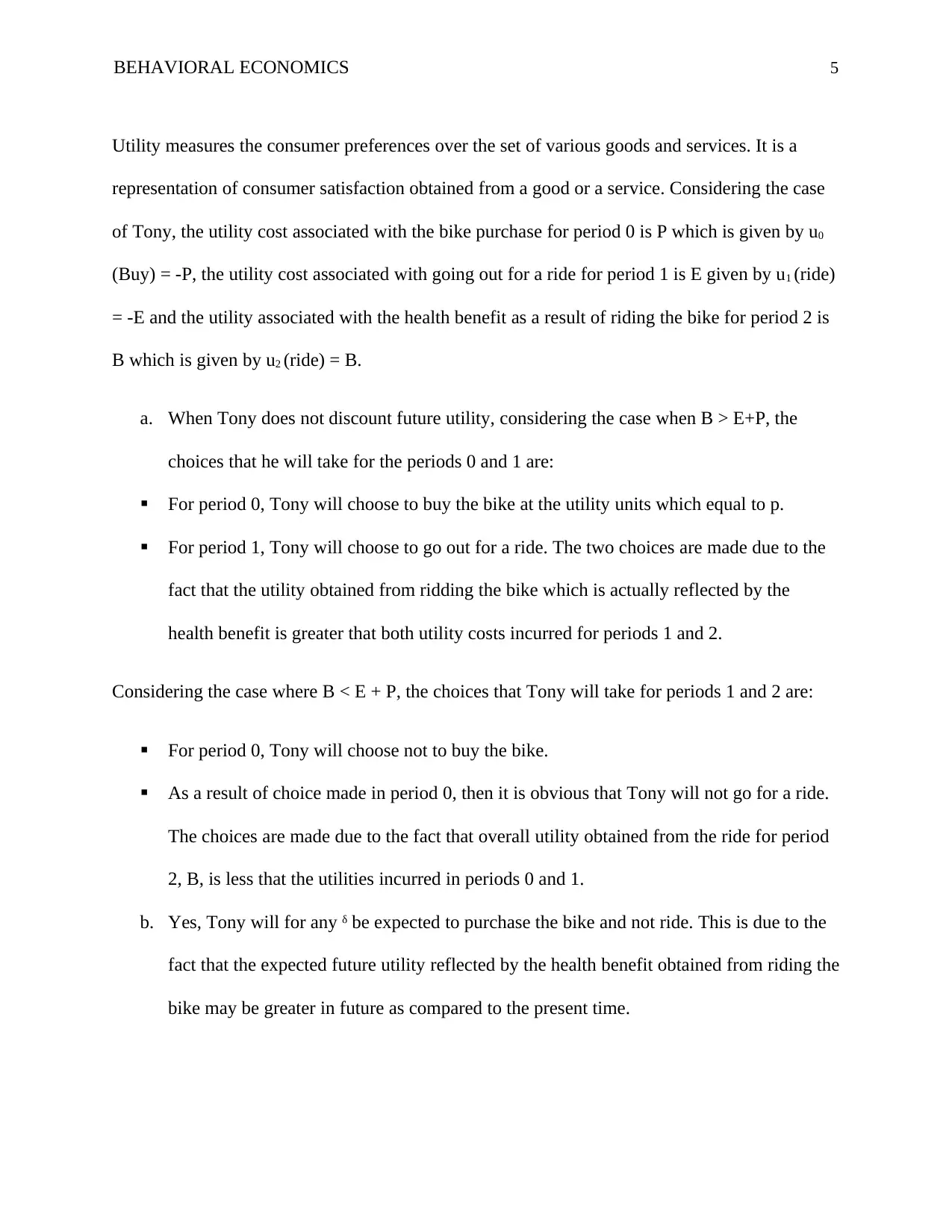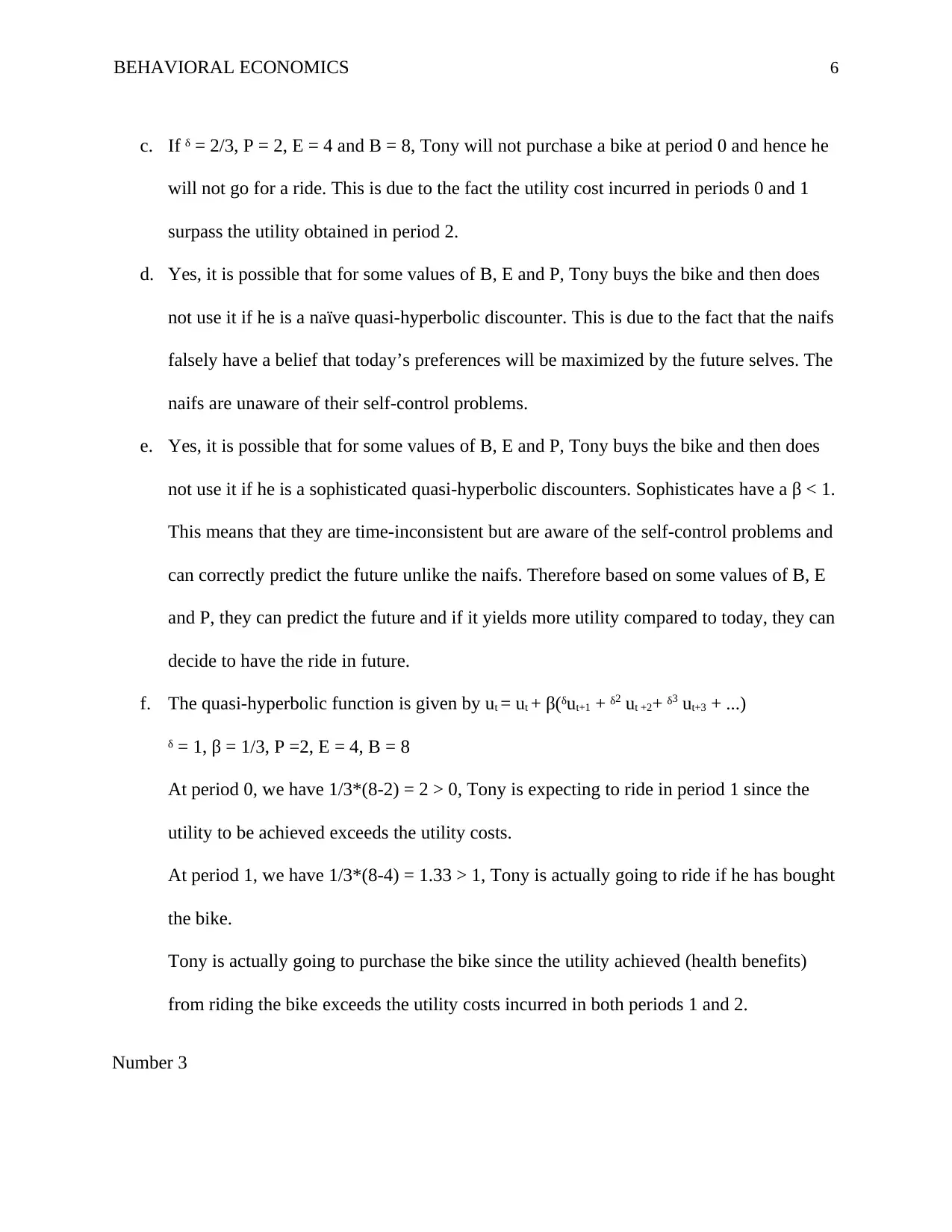Behavioral Economics Assignment: Analyzing Utility and Game Theory
VerifiedAdded on 2023/06/11
|7
|1474
|363
Homework Assignment
AI Summary
This assignment solution delves into various aspects of behavioral economics, addressing multiple-choice questions and problem-solving scenarios. It covers topics such as expected utility maximization, prospect theory, and quasi-hyperbolic discounting. The solution analyzes Lucy's risk aversion using prospect theory and explores Tony's bike purchase decision under different discounting scenarios. Furthermore, it examines Nash equilibria in cooperative and competitive settings, providing detailed explanations and answers. The document illustrates key concepts in behavioral economics with practical examples and analyses, offering a comprehensive understanding of the subject matter. Desklib provides more solved assignments and study resources for students.

BEHAVIORAL ECONOMICS 1
BEHAVIORAL ECONOMICS
Student Name
Institutional Affiliation
Facilitator
Course
Date
BEHAVIORAL ECONOMICS
Student Name
Institutional Affiliation
Facilitator
Course
Date
Paraphrase This Document
Need a fresh take? Get an instant paraphrase of this document with our AI Paraphraser

BEHAVIORAL ECONOMICS 2
Answers
Practice Questions
1. True
2. True
3. True
4. True
5. True
6. False
7. True
8. False
9. True
10. True
Problems Answers
Number 1
a. Lucy’s current wealth is $ 100 000; the chances of getting off and not paying and the
chances of paying the fine plus the court cost are both 50%
Utilities associated with the probabilities are:
The utility of getting off and not paying the fine considering the 0.5 probability is 100.
Answers
Practice Questions
1. True
2. True
3. True
4. True
5. True
6. False
7. True
8. False
9. True
10. True
Problems Answers
Number 1
a. Lucy’s current wealth is $ 100 000; the chances of getting off and not paying and the
chances of paying the fine plus the court cost are both 50%
Utilities associated with the probabilities are:
The utility of getting off and not paying the fine considering the 0.5 probability is 100.

BEHAVIORAL ECONOMICS 3
The utility of paying the fine considering the 0.5 probability is 50.
This contributes to a function 2y + x = 0, the graph drawn represents wealth in the y-axis
and fine in the x-axis.
b. Lucy cannot be an expected utility maximize in this case. She is risk averse, she chooses
to remain with her wealth rather than gamble and also chooses to pay the fine rather than
go to court.
c. By the use of the prospect theory, losses and gains are evaluated considering the both
cases; going to court and winning and going to court and losing. The valuation reference
point is the current wealth of Lucy which is $100000. It is plotted on the y-axis against
the gains and losses in the x-axis.
The utility of paying the fine considering the 0.5 probability is 50.
This contributes to a function 2y + x = 0, the graph drawn represents wealth in the y-axis
and fine in the x-axis.
b. Lucy cannot be an expected utility maximize in this case. She is risk averse, she chooses
to remain with her wealth rather than gamble and also chooses to pay the fine rather than
go to court.
c. By the use of the prospect theory, losses and gains are evaluated considering the both
cases; going to court and winning and going to court and losing. The valuation reference
point is the current wealth of Lucy which is $100000. It is plotted on the y-axis against
the gains and losses in the x-axis.
⊘ This is a preview!⊘
Do you want full access?
Subscribe today to unlock all pages.

Trusted by 1+ million students worldwide

BEHAVIORAL ECONOMICS 4
d. The feature that is responsible for Lucy rejecting the gamble in the prospect theory is the
risk-averseness. She chooses to remain with what she has and would rather pay $500 fin
than go to court and lose and pay $1000.
e. The functional form for the value function, 2y + x = 0 can be clearly used to explain
Lucy’s case. With this functional form, the probabilities for gaining and losing are equal.
It is clearly shown that any rise in the probability for winning the case in court increases
Lucy’s utility and the more she tends to fulfill her choice of going to court.
Number 2
d. The feature that is responsible for Lucy rejecting the gamble in the prospect theory is the
risk-averseness. She chooses to remain with what she has and would rather pay $500 fin
than go to court and lose and pay $1000.
e. The functional form for the value function, 2y + x = 0 can be clearly used to explain
Lucy’s case. With this functional form, the probabilities for gaining and losing are equal.
It is clearly shown that any rise in the probability for winning the case in court increases
Lucy’s utility and the more she tends to fulfill her choice of going to court.
Number 2
Paraphrase This Document
Need a fresh take? Get an instant paraphrase of this document with our AI Paraphraser

BEHAVIORAL ECONOMICS 5
Utility measures the consumer preferences over the set of various goods and services. It is a
representation of consumer satisfaction obtained from a good or a service. Considering the case
of Tony, the utility cost associated with the bike purchase for period 0 is P which is given by u0
(Buy) = -P, the utility cost associated with going out for a ride for period 1 is E given by u1 (ride)
= -E and the utility associated with the health benefit as a result of riding the bike for period 2 is
B which is given by u2 (ride) = B.
a. When Tony does not discount future utility, considering the case when B > E+P, the
choices that he will take for the periods 0 and 1 are:
For period 0, Tony will choose to buy the bike at the utility units which equal to p.
For period 1, Tony will choose to go out for a ride. The two choices are made due to the
fact that the utility obtained from ridding the bike which is actually reflected by the
health benefit is greater that both utility costs incurred for periods 1 and 2.
Considering the case where B < E + P, the choices that Tony will take for periods 1 and 2 are:
For period 0, Tony will choose not to buy the bike.
As a result of choice made in period 0, then it is obvious that Tony will not go for a ride.
The choices are made due to the fact that overall utility obtained from the ride for period
2, B, is less that the utilities incurred in periods 0 and 1.
b. Yes, Tony will for any ᵟ be expected to purchase the bike and not ride. This is due to the
fact that the expected future utility reflected by the health benefit obtained from riding the
bike may be greater in future as compared to the present time.
Utility measures the consumer preferences over the set of various goods and services. It is a
representation of consumer satisfaction obtained from a good or a service. Considering the case
of Tony, the utility cost associated with the bike purchase for period 0 is P which is given by u0
(Buy) = -P, the utility cost associated with going out for a ride for period 1 is E given by u1 (ride)
= -E and the utility associated with the health benefit as a result of riding the bike for period 2 is
B which is given by u2 (ride) = B.
a. When Tony does not discount future utility, considering the case when B > E+P, the
choices that he will take for the periods 0 and 1 are:
For period 0, Tony will choose to buy the bike at the utility units which equal to p.
For period 1, Tony will choose to go out for a ride. The two choices are made due to the
fact that the utility obtained from ridding the bike which is actually reflected by the
health benefit is greater that both utility costs incurred for periods 1 and 2.
Considering the case where B < E + P, the choices that Tony will take for periods 1 and 2 are:
For period 0, Tony will choose not to buy the bike.
As a result of choice made in period 0, then it is obvious that Tony will not go for a ride.
The choices are made due to the fact that overall utility obtained from the ride for period
2, B, is less that the utilities incurred in periods 0 and 1.
b. Yes, Tony will for any ᵟ be expected to purchase the bike and not ride. This is due to the
fact that the expected future utility reflected by the health benefit obtained from riding the
bike may be greater in future as compared to the present time.

BEHAVIORAL ECONOMICS 6
c. If ᵟ = 2/3, P = 2, E = 4 and B = 8, Tony will not purchase a bike at period 0 and hence he
will not go for a ride. This is due to the fact the utility cost incurred in periods 0 and 1
surpass the utility obtained in period 2.
d. Yes, it is possible that for some values of B, E and P, Tony buys the bike and then does
not use it if he is a naïve quasi-hyperbolic discounter. This is due to the fact that the naifs
falsely have a belief that today’s preferences will be maximized by the future selves. The
naifs are unaware of their self-control problems.
e. Yes, it is possible that for some values of B, E and P, Tony buys the bike and then does
not use it if he is a sophisticated quasi-hyperbolic discounters. Sophisticates have a β < 1.
This means that they are time-inconsistent but are aware of the self-control problems and
can correctly predict the future unlike the naifs. Therefore based on some values of B, E
and P, they can predict the future and if it yields more utility compared to today, they can
decide to have the ride in future.
f. The quasi-hyperbolic function is given by ut = ut + β(ᵟut+1 + ᵟ2 ut +2+ ᵟ3 ut+3 + ...)
ᵟ = 1, β = 1/3, P =2, E = 4, B = 8
At period 0, we have 1/3*(8-2) = 2 > 0, Tony is expecting to ride in period 1 since the
utility to be achieved exceeds the utility costs.
At period 1, we have 1/3*(8-4) = 1.33 > 1, Tony is actually going to ride if he has bought
the bike.
Tony is actually going to purchase the bike since the utility achieved (health benefits)
from riding the bike exceeds the utility costs incurred in both periods 1 and 2.
Number 3
c. If ᵟ = 2/3, P = 2, E = 4 and B = 8, Tony will not purchase a bike at period 0 and hence he
will not go for a ride. This is due to the fact the utility cost incurred in periods 0 and 1
surpass the utility obtained in period 2.
d. Yes, it is possible that for some values of B, E and P, Tony buys the bike and then does
not use it if he is a naïve quasi-hyperbolic discounter. This is due to the fact that the naifs
falsely have a belief that today’s preferences will be maximized by the future selves. The
naifs are unaware of their self-control problems.
e. Yes, it is possible that for some values of B, E and P, Tony buys the bike and then does
not use it if he is a sophisticated quasi-hyperbolic discounters. Sophisticates have a β < 1.
This means that they are time-inconsistent but are aware of the self-control problems and
can correctly predict the future unlike the naifs. Therefore based on some values of B, E
and P, they can predict the future and if it yields more utility compared to today, they can
decide to have the ride in future.
f. The quasi-hyperbolic function is given by ut = ut + β(ᵟut+1 + ᵟ2 ut +2+ ᵟ3 ut+3 + ...)
ᵟ = 1, β = 1/3, P =2, E = 4, B = 8
At period 0, we have 1/3*(8-2) = 2 > 0, Tony is expecting to ride in period 1 since the
utility to be achieved exceeds the utility costs.
At period 1, we have 1/3*(8-4) = 1.33 > 1, Tony is actually going to ride if he has bought
the bike.
Tony is actually going to purchase the bike since the utility achieved (health benefits)
from riding the bike exceeds the utility costs incurred in both periods 1 and 2.
Number 3
⊘ This is a preview!⊘
Do you want full access?
Subscribe today to unlock all pages.

Trusted by 1+ million students worldwide

BEHAVIORAL ECONOMICS 7
a. A Nash equilibrium results when the both players chose mutually the best responses.
Each player chooses the strategy which maximizes his or her utility in as much as the
opponent’s strategies are concerned. The pure-strategy Nash equilibria with purely
selfish preferences are the choice to work both (4, 4) or the choice to shirk both and fail
(0, 0).
b. Yes, there are other outcomes. The outcomes result to a mixed-strategy Nash equilibria.
They are the choice to work and shirk (5, 1) and the choice to shirk and work (1, 5). This
is due to the fact that no one is willing to incur the cost and obtain low marks just the
same as the one who shirks but does not incur any cost.
c. Under this situation, the students are cooperative. They may decide to both work together
and obtain a good mark even if they incur costs or decide that one of them should do it
and be compensated by the other. The Nash equilibria can either be a pure strategy one at
(4, 4) or a mixed one at (1, 5) and (5, 1).
d. In this situation, the Nash equilibria is a pure-strategy one at (4, 4) where the both
students prefer to work hard and get a good mark. The competition effect stirs them up to
work for the best as no one wants to be outdone by the other.
e. The pure-strategy Nash equilibria will be (4, 4) and (0, 0). This is due to the fact that the
difference in the each unit of payoffs makes the students to lose half a unit of utility. As
each student aims at maximizing utility, no one is willing to lose half unit of utility due to
difference in payoffs units and thus adopt similar payoff units.
a. A Nash equilibrium results when the both players chose mutually the best responses.
Each player chooses the strategy which maximizes his or her utility in as much as the
opponent’s strategies are concerned. The pure-strategy Nash equilibria with purely
selfish preferences are the choice to work both (4, 4) or the choice to shirk both and fail
(0, 0).
b. Yes, there are other outcomes. The outcomes result to a mixed-strategy Nash equilibria.
They are the choice to work and shirk (5, 1) and the choice to shirk and work (1, 5). This
is due to the fact that no one is willing to incur the cost and obtain low marks just the
same as the one who shirks but does not incur any cost.
c. Under this situation, the students are cooperative. They may decide to both work together
and obtain a good mark even if they incur costs or decide that one of them should do it
and be compensated by the other. The Nash equilibria can either be a pure strategy one at
(4, 4) or a mixed one at (1, 5) and (5, 1).
d. In this situation, the Nash equilibria is a pure-strategy one at (4, 4) where the both
students prefer to work hard and get a good mark. The competition effect stirs them up to
work for the best as no one wants to be outdone by the other.
e. The pure-strategy Nash equilibria will be (4, 4) and (0, 0). This is due to the fact that the
difference in the each unit of payoffs makes the students to lose half a unit of utility. As
each student aims at maximizing utility, no one is willing to lose half unit of utility due to
difference in payoffs units and thus adopt similar payoff units.
1 out of 7
Your All-in-One AI-Powered Toolkit for Academic Success.
+13062052269
info@desklib.com
Available 24*7 on WhatsApp / Email
![[object Object]](/_next/static/media/star-bottom.7253800d.svg)
Unlock your academic potential
Copyright © 2020–2025 A2Z Services. All Rights Reserved. Developed and managed by ZUCOL.
